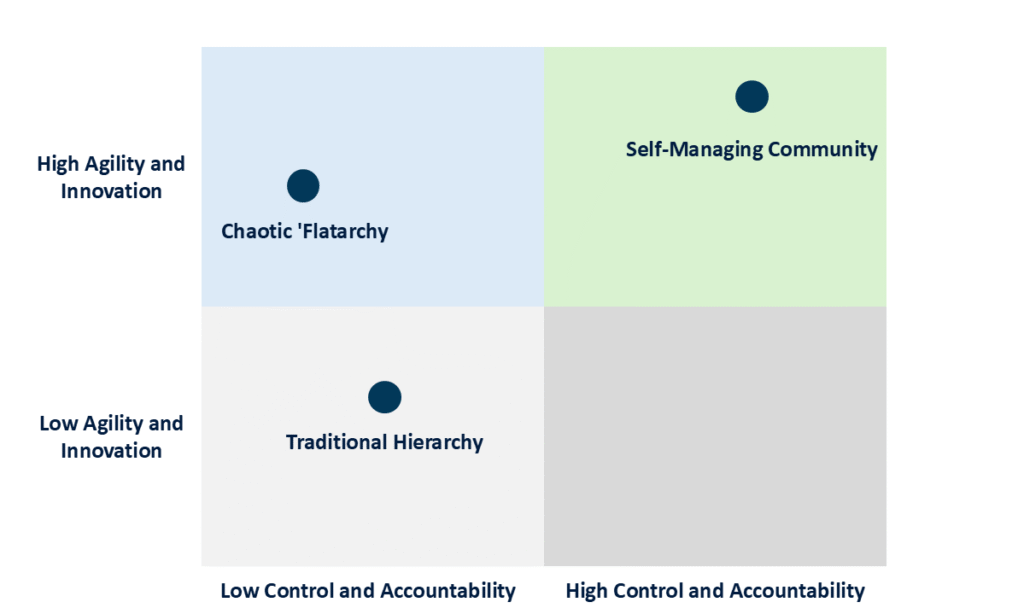In the architecture of the 20th-century enterprise, the pyramid was king. A rigid hierarchy of command-and-control was the default operating system for businesses aiming for scale and efficiency. Orders flowed down; reports flowed up. But in today’s volatile, complex, and hyper-connected economy, that pyramid is crumbling. The old system is too slow, too inflexible, and utterly incapable of unlocking the full potential of a modern workforce.
The future belongs to a new model: the self-managing organization. This isn’t a utopian fantasy of flatarchy with no rules. It is a deliberate, designed Community of empowered teams, aligned by a common purpose and guided by a new set of principles. The goal is not to eliminate leadership, but to distribute it, creating an organization that is simultaneously more agile, more innovative, and more human.
This shift from Command to Community is the most critical strategic redesign a leader can undertake.
The Burning Platform: Why Command-and-Control is Failing
The data is unequivocal. Traditional hierarchical structures are struggling to keep pace:
-
-
- Over 60% of complex, large-scale change initiatives fail to achieve goals, often due to lack of management support and employee resistance.
- Only 20% of executives say their companies are effectively leveraging the power of flatter, more agile organizational models.
- Disengagement is costly. Teams with low engagement see nearly 20% lower productivity and 15% lower profitability. A primary driver of disengagement? A lack of autonomy and voice.
-
The cost of inertia is no longer merely inefficiency; it is irrelevance. In a world where innovation cycles are measured in weeks, not years, waiting for decisions to climb up and down an org chart is a recipe for failure.
The Pillars of the Self-Managing Community
Building an organization that scales without traditional hierarchy requires installing four foundational pillars:
1. Radical Clarity of Purpose and Strategy:
In a system without micromanagement, a compelling “North Star” is non-negotiable. Every individual and team must understand the what and, more importantly, the why. This purpose, combined with clear strategic priorities (often embodied in frameworks like OKRs – Objectives and Key Results), provides the guardrails within which teams can operate autonomously. It aligns action without the need for approval layers.
2. Empowered, Cross-Functional Teams:
This is the engine room of the community. Structure your organization around small, multidisciplinary teams (often called “squads,” “cells,” or “pods”) that are given a clear problem to solve and the authority to solve it. They own their outcomes, manage their workflows, and are accountable to each other and the broader mission. This is where accountability shifts from an individual manager to a collective team.
3. Transparent Information Flow:
Information is power. In a command structure, power is hoarded. In a community, it is shared radical transparency. This means open access to financial data, strategic updates, performance metrics, and even compensation bands. Tools like Slack, Notion, and quarterly all-hands meetings become the central nervous system, ensuring everyone has the context needed to make intelligent, aligned decisions without seeking permission.
4. A New Leadership Model: The Coach-Architect:
This is the most profound shift for leaders. Their role evolves from director to coach-architect. They are no longer the sole decision-makers but are responsible for:
-
-
- Designing and nurturing the system (the “architecture”).
- Developing people and helping remove obstacles (the “coaching”).
- Holding the space for the community to thrive, ensuring adherence to principles and purpose.
-
The Scaling Challenge: From Experiment to Ecosystem
The most common objection to this model is scale. “It works for a 50-person startup, but not for a 5,000-person enterprise.” This is a myth. The world’s most agile large enterprises operate as a network of interconnected teams.
Scaling a community model requires following key aspects which hold these teams together:
-
-
- Dynamic Governance: Implement lightweight frameworks for decision-making like RAPID or DACI that clarify who has input, who recommends, and who decides for cross-team initiatives.
- Peer Feedback & Performance Systems: Move away from annual reviews by a single manager. Implement continuous, multi-source feedback (from peers, stakeholders, customers) that focuses on development and contribution to the community.
- Common Platforms & Infrastructure: Provide shared resources (e.g., data platforms, HR systems, legal support) that enable teams to move quickly without reinventing the wheel.
-
The Result: A Quantifiable Competitive Advantage
The organizations that successfully make this transition don’t just feel better – they perform better. They see dramatic improvements in key metrics:

The Impact of Organization Model
This graph illustrates the sweet spot achieved by a well-designed self-managing community. It simultaneously maximizes agility/innovation and control/accountability, a combination traditional hierarchies struggle to achieve.
Your First Step: Begin the Dialogue
Transforming from command to community is not a flip you switch. It is a conscious, cultural evolution.
Start by asking your leadership team these questions:
-
-
- Where in our organization do decisions get bottlenecked?
- Do our people have the context and information they need to act without guidance?
- Are we leaders primarily directing work or developing capability and designing systems?
-
The journey begins with a single step: the decision to trust your people not just to execute, but to decide, to innovate, and to lead. The goal is to build an organization that doesn’t just scale but evolves – naturally, resiliently, and intelligently.
Ready to build a more agile and empowered organization? Contact our Organization Strategy practice to begin your transformation journey.



